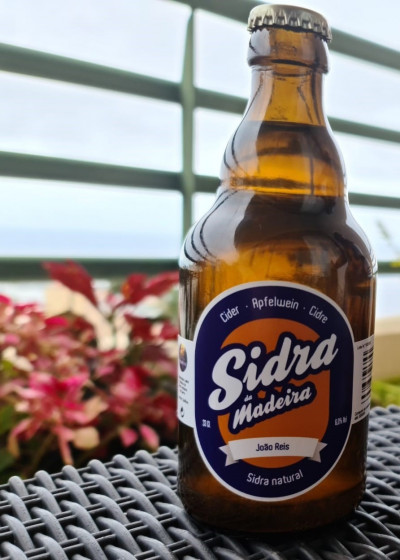Description: Sidra da Madeira is the fermented drink obtained from the natural juice of fresh apple (Malus domestica Borkh.) fruit and sometimes also of mixtures of apple and pear (Pyrus communis L.) from traditional and other varieties of these species, exclusively produced on Madeira Island, which is produced following a traditional or particular production methods of the island
In general terms, Sidra da Madeira has: a minimum alcohol content of 5% (by volume at 20. ºC); a maximum fermentable sugar content of 15 g/l; a total acidity (in malic acid) of at least 3 g/l, possibly reaching 10 g/l; a maximum volatile acidity (expressed as acetic acid) of 1.8 g/l and a maximum total sulphur dioxide content of 200 mg/l, expressed as SO2.
The “blends” or combinations of different varieties of fresh apples or mixes of fresh apples and pears transformed to produce Sidra da Madeira , make it to present different colours that can go from bright citrus to straw yellow, with orange nuances. It may either be turbid or clearer, when filtered.
It has a genuine and fresh aroma, which reveals a fruity character of medium to strong intensity, with clear notes of green apple, ripe apple, quince and/or citrus, forming a balanced and pleasant set.
Sidra da Madeira is usually still but can be carbonated (by addition of carbon dioxide), and its flavour is slightly sweet and light, which evolves showing harmony between its acidity and bitterness, ending up dry and standing out due to the strong presence of apple in the aroma and flavour and by the freshness granted by its unique acidity.
Production method: Sidra da Madeira is made from fresh apples and sometimes also from mixes of fresh apples and pears exclusively from local production.
Traditional varieties used in its production are apples: “Barral”; “Cara-de-dama”; “Branco”; “Bico de Blackbird”; “Da Festa”; “Domingos”; “Da Ponta do Pargo”; “Calhau”; “Mute snout” and “Vime”; and, in some cases, also pears: “Do Santo” and “Tenra de São Jorge”.
The centuries-old practice of Madeiran farmers in the propagation and sharing of genetic material from the trees and fruits with the best characteristics, determines that other cultivated forms of apples and pears trees are still in production, whose fruits, although in a lesser extent, can also be used in lots intended for the production of Sidra da Madeira.
Also, some exotic varieties aimed for fresh consumption, such as apples: “Golden”, “Fuji”, “Starking”, “Royal Gala”, and “Reineta”, and “Rocha” pear, when available at the farm or when are exclusively produced on the island, can be used in its production.
The mixtures or “blends” of this diversity of traditional and other varieties of apples and pears, produced on the island and more or less acidic, bitter, or sweet, that contribute to the characteristics of richness of colours, aromas and flavours and to the refreshing acidity, which distinguish the Sidra da Madeira from the various island locations and from the different producers.
For the preparation of Sidra da Madeira, the fruits when ripe are selected and washed, before crushed and pressed to extract the natural must, which is placed in wood containers, stainless steel tanks or other reservoirs, where the fermentation begins.
Fermentation usually occurs only with the natural compounds and the conditions from the fruits and the microorganisms from the must and the fermentation containers. However, it is possible to use some technology products and to apply oenological practices and treatments approved for natural ciders, including those intended to obtain carbonated ciders.
From the experience accumulated over generations, in each production area, Madeiran producers know how long after the "tumultuous fermentation" ends should their cider rest to stabilize. Nevertheless, Sidra da Madeira stands out for keeping a pronounced acidity that comes mainly from the effect of the acid soils of the island on the fresh apples or mixes of fresh apples and pears that originates this cider.
Once this resting is complete, Sidra da Madeira is ready, and can be transfer to the wooden casks or barrels or to more inert containers, where is stored until bottling or packaging in proper containers (barrels or carboys), intended for beverage establishments or restaurants for subsequent retail sale to the final consumer.
Special features: Sidra da Madeira distinguish itself for being a natural cider (sometimes also carbonated), which presents a great diversity of colours, aromas and flavours and also a vibrant acidity that give it a high repute among consumers and that are resultant from the fermentation of natural juice, obtain by the pressing of different blends of fresh apples and, sometimes, also of mixes of fresh apples and pears, from traditional varieties and other varieties of these species, grown and harvested on orchards from different locations of Madeira Island, with temperate microclimates, and with soils of acidity, more or less, accentuated, that contribute to the principal organoleptic characteristics of Sidra da Madeira.
Sidra da Madeira has also great prestige among producers and consumers for the high importance that this production has always had for the populations of some localities of the island, with favourable conditions, for the propagation of orchards of the fresh fruit that give it rise, where its traditional production mode was developed and where have also been introduced new practices, authorized in this type of drink, to improve and differentiate its production. In these localities, every year, are held “Festas” and ethnographic events to promote Sidra da Madeira and the fruits used in its production.
Production area: All stages of its production, from the production of the raw material to the extraction operations of natural juice, to the fermentation and to its stage and conservation take place on the Madeira island.
History: Madeira Island, located in the subtropical region of the North Atlantic, has a volcanic origin and a pronounced orography, with very irregular, that form a central mountain chain of east-west orientation and high altitudes (above 1200 meters). Its geographic situation determines a mild climate and a reduced temperature range, except in the higher areas. The island's orography and its exposure to the trade winds determine the existence of a wide variety of microclimates and a sunny and protected south slope, while the north slope is darker, cooler, and more humid.
Dominant soils of basaltic material, have different edaphic characteristics, depending on the increase in altitude and the consequent change in their climate, with increased precipitation and decrease in temperature, so the production of the fruits used in Sidra da Madeira, are concentrated in localities with more temperate and humid microclimates on the island, mainly above 400 meters of altitude on the south slope and 300 meters on the north slope, where predominate Cambisols and Andosols with semi-acidic to acidic characteristics and with good aeration and drainage conditions, that contributed to the easy installation and propagation of pome fruits.
Among first fruit trees introduced on the island by Portuguese settlers, were some varieties of apples and pears, that found good conditions on the island. It’s believed that cider production on Madeira Island began as soon as the orchards began to produce sufficient amounts of fruit for its, as reported by the Chronicler Gomes Eanes de Zurara (1410-1474) and others historical records that mention that it was possible to find cider, then called “Vinho de Peros” (apple wine), among the supplies that, since the mid-15th century, Portuguese Navigators came to get from Madeira Island.
During the 17th to the 19th centuries, the production of this “vinho de peros” followed the development of Madeira Wine production, using the same "lagares" (presses) and, in some cases, even adulterating it. At the beginning of the 20th century, became prohibited the vinification of pears and apples used in the production of false Madeira Wine. This ban made that many regional producers started to promote the fermentation of theirs fresh juice of apples and pears, for production of “a new drink”, that they started to call “cidra” or “sidra”, and, more recently, Sidra da Madeira to differentiate it from the productions of other origins.
To the development of this production, greatly contributed, the article published, by Eng. João da Mota Prego (1859-1931), in 1906, where described the procedures to be adopted in the “manufacture of cider in Madeira”, inviting local producers to adopt this production. Many producers still today follow their recommendations. Also, Eng. Vieira Natividade (1899-1968), in 1947, when describing the state of development of Madeira's fruit growing, characterized the great diversity of varieties of apples and pears prevailing on the island and identified the localities that then maintained the tradition of cider production.
The ease dissemination of pomes trees allowed the emergence of several traditional varieties that came from the first ones brought by Portuguese settlers and later from the ones introduced by the British who inhabited the island between the 17th to the 19th centuries, and which were selected and preserved by Madeiran producers in various zones of the island, preserving those more adapted to the local conditions and that provided fruits with the best characteristics for fresh consumption and for cider production, and which later, by grafting, were reproduced and propagated in other areas of the island with similar edaphoclimatic characteristics.
This practice over the centuries allowed the development of the main traditional varieties, and also more recent introduction of other commons varieties of apples and pears, grown and harvested in Madeiran orchards and which are also used by some producers in the production of their ciders, obtained according to the traditional production methods, and which are also distinguished by their sharp acidity.
The attributes of colour, aroma and flavours and it's remarkable acidity, linked to edaphoclimatic conditions and to the mixes of diverse varieties of apples and sometimes also apples and pears used in it's different production areas, have allowed Sidra da Madeira to obtain several prizes at the nationals competitions: "Traditional ciders and beers" and "Great Taste - Portugal", but are local consumers and, increasingly, tourists, which give it great notoriety.
All the historical references that, in the last 600 years, document the importance of “vinho de peros”, “cidra” or “sidra” and “Sidra da Madeira” production on Madeira island, leads local producers to claim that it production has been active since the beginning of the settlement till today and justifies that production and consumption of Sidra da Madeira are so representative throughout the island, but mainly in São Roque do Faial – Santana, de Santo António da Serra – Machico, da Camacha – Santa Cruz, do Jardim da Serra – Câmara de Lobos, da Ponta do Pargo e dos Prazeres – Calheta, where every year are organized several “Festas” or ethnographic and sociocultural events to promote Sidra da Madeira and the fresh fruits that originate this special drink.
Product specification (pdf)
Single Document (pdf)
Producer group
APSRAM - Associação de Produtores de Sidra da Região Autónoma da Madeira
Control and certification body
CTAC-RAM - Comissão Técnica de Avaliação da Conformidade dos Produtos Agrícolas e dos Géneros Alimentícios da Região Autónoma da Madeira
Publication in EU official journal
Official Journal L208 23.08.2023
Publication in the Portuguese official journal
Aviso nº. 18/2020/M de 14.05.2020
Despacho nº. 1/2020/M de 27.10.2020
Aviso n.º 453/2021 de 23.07.2021



